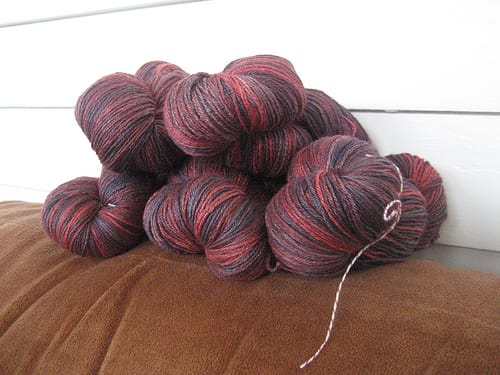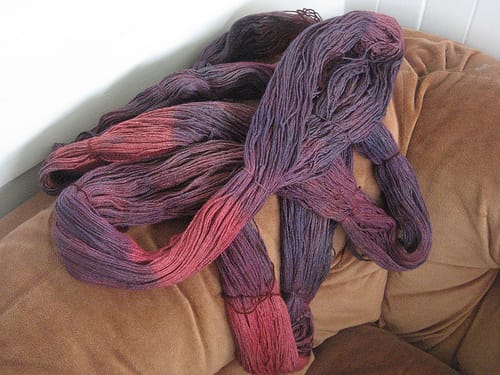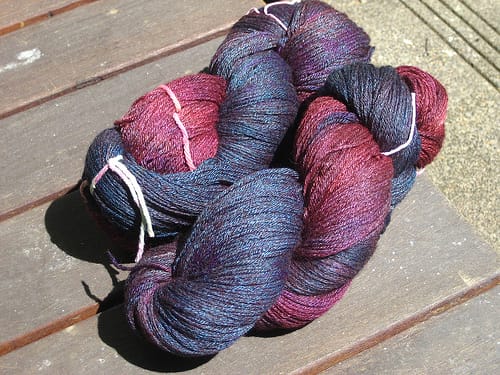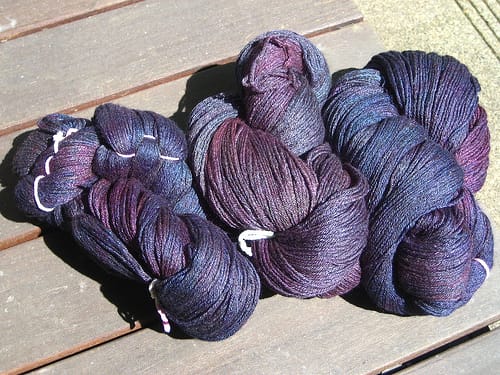I’ve been talking about overdyeing a lot for the last week, but today I want to share the results of a dye project I did on Bare yarn. I’ve been admiring Kristen Rengren’s Zora Cardigan ever since the design was published last winter, and really want to make one this summer. I love the effect of the hand-dyed yarn in the original, too, and didn’t have anything like that in my stash in the right quantity, but I also have too much stash (and not enough in the budget!) to justify buying so much yarn for a new sweater!
I did, however, have 5 skeins of our Bare Merino/silk yarn just waiting to be dye projects.

That’s what it looked like after the FIRST round of dyeing. I had to go through two more to get what I wanted! Read on to find out more…
So my idea for this yarn was simple. Well, it seemed simple at the time! I wanted a dark color with depth and interest, with maybe the slightest peeks of ruby red and sapphire. But I underestimated how much dye 500 grams of yarn was going to need! I used red food coloring and blue food coloring to get these colors (these are the same skeins as above before being re-skeined) and a dip-dye method. First I dyed the whole batch with the red, and than dipped half or more of the skeins in blue while the remaining red portions rested in clear water. I used an enamel bowl in the dyepot to hold the blue dye and it acted kind of like a double-boiler.

I like the colors, but they are less saturated than I wanted. Instead of a dark color, I have a middle tone, and the red is not really ruby-red but more of a watermelon. An once I reskeined these, I saw that there was too much red in proportion to the base color. Rather than get little pops of red, when this was knitted up, I would have long streaks of it.
So, back in the dyepot it went! I overdyed the whole batch with waaaay more red than I used the first time. Then I went hiking for the day and forgot to turn off the stove! So…maybe it burned a little? Anyway, I didn’t have red at the end but a sort of wine color instead. And then I dipped again into a lot of blue dye. And THEN I sprinkled the finished skeins with some neon purple food coloring, in an attempt to bring the red tone back to a jewel tone. This is what I got:

I kind of love this, but it has issues that make it unsuitable for the sweater I wanted to make! First of all, it’s much too high-contrast–the red and blue sections will knit up unpredictably and cause weird pooling and flashing. I wanted a yarn with less contrast. This would be great as a pair of cool stockings, a simple scarf, or some opera gloves though, wouldn’t it? So I left these two skeins as they were and only went ahead and dyed the other three for a third time
For the third (and final!) trip to the dyepot, I decided to make it my main goal to tone down the variegation. I overdyed the three skeins (it will still be enough for the sweater, in case you were worried!) with Wilton’s icing dye in black, which is a really interesting and complex color. When exposed to vinegar, it “breaks” or separates into its component colors, which turn out to be teal and hot pink! So, I used very little vinegar at first, and then added more and more, gradually, hoping to tone down the variegation of my yarn but also encourage some breakage late in the process, to help the reds and blues read more as jewel tones. And I finally got what I was after:

There’s enough variety of color now to give the finished fabric some interest, but my hope is that it is now uniform enough not to obscure the stitch patterns I’ll be using. The silk and the wool have taken up the colors at different rates, so there is a heathered effect to the final colorway as well. Overall I’m quite pleased, even though this project took much longer than I anticipated!
I also notice that I have mentioned about 3 sweaters I want to make in a single week of blog posts! I need to get to work if I’m going to get any of these finished!!



